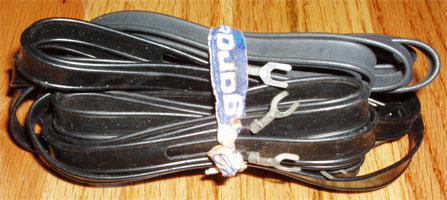You remember this stuff, right? Two wires with a fat piece of plastic between them. Bare wire or lugs at the end. If you’re old enough to remember knobs on TVs, you’ve probably seen your share of it. No one uses that 300 ohm flat antenna wire anymore, though. Did you ever wonder why?
Here’s the simple answer: coaxial cable is better. Coaxial cable is much more resistant to interference. It’s more durable, too. Not that the old flat wire is unsafe or anything — if you’re using it now there’s no reason to stop. If you’re wiring a new antenna though, you’ll find that the connection you get from that antenna is always coax.
Which leads us to the question, if coax is so much better, why did anyone ever use twin-lead cable at all? It’s cheaper to make, and it does actually perform better over long distances than coax if there isn’t any interference. The big reason though, is impedance. Impedance is that hard-to-explain characteristic of wire that represents how much a circuit opposes the introduction of current into it. One way of imagining it is to think of a clogged pipe, and how much the clog in the pipe stops the water from flowing. (That’s not technically accurate but it gives you some idea.)
Whether or not you can wrap your head around impedance, the point here is that twin-lead wire is much more similar in impedance to the antenna itself. You don’t need a transformer to go from the antenna to the wire. With coax, you do. That’s one more part that was hard to make in the old days, and expensive too.
Today, we don’t have to worry much about the cost of a matching transformer that converts a signal from 300 ohms to 75 ohms (which is what coax uses.) So, we’re free to use coax cable and enjoy its superior shielding and freedom from interference. It’s a little more expensive, but not enough to make a huge difference.





